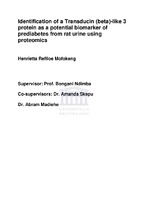| dc.contributor.advisor | Ndimba, Bongani | |
| dc.contributor.advisor | Skepu, Amanda | |
| dc.contributor.author | Mofokeng, Henrietta Refiloe | |
| dc.contributor.other | Dept. of Biotechnology | |
| dc.contributor.other | Faculty of Science | |
| dc.date.accessioned | 2013-06-18T06:58:28Z | |
| dc.date.available | 2013/02/26 11:23 | |
| dc.date.available | 2013/02/26 | |
| dc.date.available | 2013-06-18T06:58:28Z | |
| dc.date.issued | 2010 | |
| dc.identifier.uri | http://hdl.handle.net/11394/1440 | |
| dc.description | Magister Scientiae - MSc | en_US |
| dc.description.abstract | Obesity is a globally increasing disease particularly in developing countries and among children. It is mainly caused by intake of diets high in fat and the lack of physical activity. Obesity is a risk factor for diseases such as type II diabetes, high blood pressure, high cholesterol and certain cancers. Prediabetes is a condition where blood glucose levels are above normal but have not reached those of diabetes. It is difficult to diagnose, as there are no signs or symptoms. Some type II diabetes patients bear no symptoms at all and the disease is discovered late. Proteomics is a field that can provide opportunities for early diagnosis of diseases through biomarker discovery. The early diagnosis of diabetes can assist in the prevention and treatment of diabetes. Therefore there is a need for the early diagnosis of diabetes. Twenty Wistar rats were used. The rats were initially fed a CHOW diet, which is the standard balanced diet for rats, for 4 weeks. The rats were then divided into 2 groups of 10 where 1 group was fed CHOW and another was fed a high fat (HF) diet in order to induce obesity. The two groups were fed their respective diets for 18 weeks. Rats were weighed. Rats were placed in metabolic chambers and 24 hour urine samples were collected. Ketone levels were measured by Ketostix. Urine proteins were precipitated by acetone, quantified and separated on both the 1D SDS-PAGE and the 2D SDS-PAGE. Protein expression changes between CHOW and HF fed rats were determined and identified using MALDI-TOF mass spectrometry. Protein spots intensities increased and decreased between the CHOW and HF fed rats. Transducin (beta)-like 3 was identified as the only differentially expressed protein, which might serve as a potential biomarker for prediabetes. | en_US |
| dc.language.iso | en | en_US |
| dc.publisher | University of the Western Cape | en_US |
| dc.subject | Obesity | en_US |
| dc.subject | Type II diabetes | en_US |
| dc.subject | Prediabetes | en_US |
| dc.subject | Biomarker discovery | en_US |
| dc.subject | Proteomics | en_US |
| dc.subject | High fat diet | en_US |
| dc.subject | 1D | en_US |
| dc.subject | SDS-PAGE | en_US |
| dc.subject | 2D SDS-PAGE | en_US |
| dc.subject | Urine | en_US |
| dc.subject | Mass spectrometry | en_US |
| dc.title | Identification of a transducin (beta)-like 3 protein as a potential biomarker of prediabetes from rat urine using proteomics | en_US |
| dc.type | Thesis | en_US |
| dc.rights.holder | University of the Western Cape | en_US |
| dc.description.country | South Africa | |

